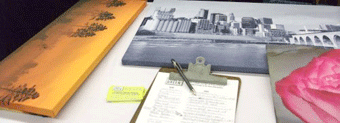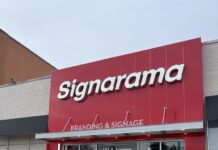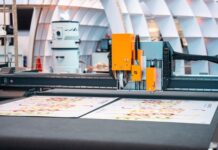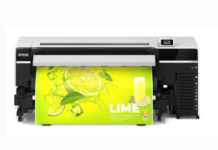
By Lori Shridhare
These days, when designers and sign professionals are looking for an alternative to vinyl that has both visual and practical benefits, they’re turning to fabric. With green options and low shipping costs, fabric is becoming a must-have material in a banner shop’s inventory.
“Fabric materials and specialty textiles like blockouts and backlits can be used in banner, point-of-purchase, interior decoration, wall covering, and soft signage applications,” suggests Jaime Giannantonio, marketing manager of digital print material provider Ultraflex Systems Inc. in Randolph, New Jersey.
 One of the basic appeals of fabric is its softness. Although visitors to a gallery or tradeshow may never touch the actual banner, the visual of a welcoming, familiar material it presents promises to draw passers-by closer.
One of the basic appeals of fabric is its softness. Although visitors to a gallery or tradeshow may never touch the actual banner, the visual of a welcoming, familiar material it presents promises to draw passers-by closer.
For Giannantonio, another distinct advantage for using a fabric in lieu of PVC, SAV, or paper is the higher-end aesthetic that it displays. “With a fabric, the overall look and feel of the graphic is cleaner and more appealing,” she expands. “And another advantage of fabrics is their lightweight construction. This helps alleviate shipping and installation costs.”
Nora Norby, president of Banner Creations in Minneapolis, Minnesota, believes that fabric exudes an inherent emotional appeal. “We all know the first thing you do when baby is born is wrap the baby in fabric. Now think about wrapping that same baby in vinyl. That thought alone is jarring,” she posits. “So on a very basic level, when customers see a corporate message on a fabric banner, they’re going to respond more favorably to their product than if the same message were on vinyl.”
Another aspect of fabric that makes it visually appealing is its ability to move while on display—the lightness and ‘airiness’ of the banner will easily catch the eye of viewers. And of course, the material can be washed and reused. “Imagine throwing your vinyl table covers into your washing machine and then into your dryer,” says Norby. “Now imagine doing the same thing with a dye-sublimated table cover. It comes out great.
“So even if the fabric table cover were a little more expensive, you can ask your customers, ‘Would you rather have a product that looks good and can be washed and reused representing your company or a vinyl table cover?”
Giannantonio finds that fabrics are actually at their most effective in banner and signage applications when the look and feel of the material used embodies the actual advertisement. “For example, Victoria’s Secret may use a light, soft, and delicate style of fabric,” she explains, “whereas Nautica may choose a canvas and GAP select a heavier denim-like fabric.”
 For sign companies used to working with the brick-and-mortar of building signs, a learning curve comes with a transition to banners. “My advice to companies working with fabric banner is first, understand your clients’ needs, both spoken and unspoken needs,” says Norby. “Also, it’s important to know whether the banner is gong to be used indoors or out, which will affect fabric choice and finishing. It’s also crucial to know whether the fabric has to be flame-retardant.”
For sign companies used to working with the brick-and-mortar of building signs, a learning curve comes with a transition to banners. “My advice to companies working with fabric banner is first, understand your clients’ needs, both spoken and unspoken needs,” says Norby. “Also, it’s important to know whether the banner is gong to be used indoors or out, which will affect fabric choice and finishing. It’s also crucial to know whether the fabric has to be flame-retardant.”
According to Giannantonio, you don’t necessarily need a dye-sublimation or screen printer to achieve bright colors and eye-catching graphics with fabrics and textiles. “With so many digitally printable fabrics available—such as our “coated” line—a solvent or UV printer will create beautiful imagery on fabric,” she says.
Once purchased, fabric has innumerable benefits for displays. Here are just a few of the advantages Norby has discovered:
* They can be ironed with a warm iron in most applications (imagine ironing those wrinkled vinyl banners you see at tradeshows):
* Sides don’t curl (like a vinyl banner in or out of a banner stand);
* Can be folded and put in a suitcase and still look good at an event;
* Many more finishing options;
* Great colors on fabric;
* Breakdown in landfills much faster than PVCs; and
* Inks used to print on them are environmentally friendly compared with solvent inks on vinyls.
When it comes to materials, Banner Creations works with fabrics made from recycled plastic bottle fabrics made by mills. Most of the mills are members of the Fabric Graphics Association, a division of Industrial Fabrics Association International (IFAI). Other companies that offer these fabrics include Dazian (which sells Eco-Trapeze), Foss Manufacturing (which offers Eco-fi fiber that makes Ecophab), and Aurora Textiles (which sells a line called Weaves of Green).
Most of these products are made from 100 percent post-consumer content. The process of turning plastic bottles into fabric is fairly simple—and the rewards, both for the environment and the end-user—are great.
After the bottles are picked up at curbside and community recycling centers, they’re sorted by type and color. They’re then cleaned, crushed, refined, purified, and chopped into flake. These tiny pieces are then melted, liquefied, and extruded from spinnerets creating fiber strands. The next step is to send these pieces to a mill, which handles the process of knitting the strands into fabric.
 Norby finds that the customers who use these fabrics are committed to supporting the environment, so the idea that taking plastic bottles out of a landfill and reusing them is an important to them. In terms of making aesthetic choices, there are different fabrics to choose from depending on the use. “As more industry develops around the eco-fabric market, more options in weights and weaves will become available,” says Norby.
Norby finds that the customers who use these fabrics are committed to supporting the environment, so the idea that taking plastic bottles out of a landfill and reusing them is an important to them. In terms of making aesthetic choices, there are different fabrics to choose from depending on the use. “As more industry develops around the eco-fabric market, more options in weights and weaves will become available,” says Norby.
Meanwhile Giannantonio points out that all Ultraflex textiles are Earth-friendly. “The polyester used in the manufacturing process is made of 20 percent recycled polyester and is 100 percent recyclable,” she says. “A water-based coating technology has been implemented into the textiles which is extremely earth friendly; between 75 and 90 percent of the coating is biodegradable.
“Beyond that, our UltraCotton fabric couldn’t be more ‘green,’ since this textile is made of 100 percent natural cotton. Because of this, it is therefore innately biodegradable/compostable and recyclable.”
So the sign industry is seeing the benefits of fabric, and this is a trend that looks promising for the next several years.
All photos courtesy of Banner Creations.











